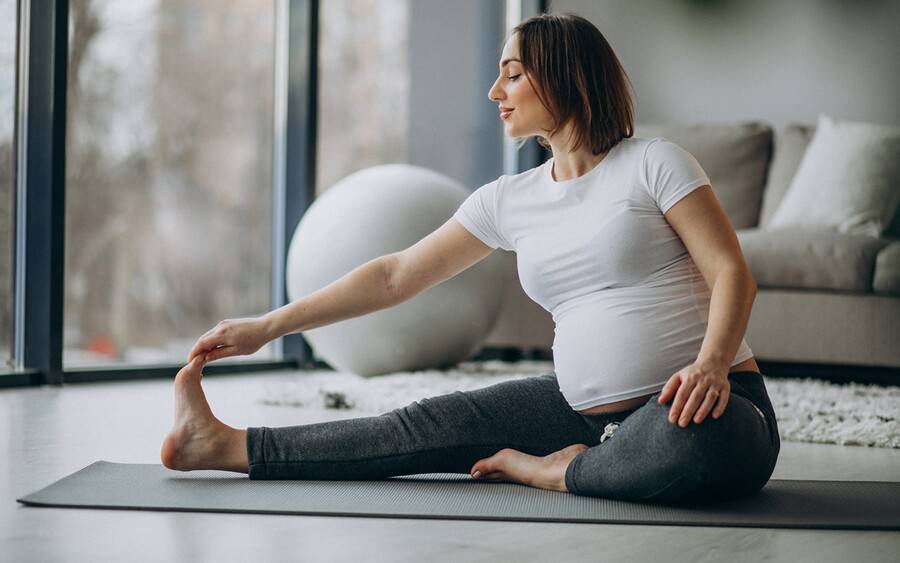Exercising During Pregnancy: Tips For Safe Pregnancy Workout

Exercising at the time of pregnancy depends on your fitness level and the trimester you are in. Along with a pregnancy workout, you need to stick to the recommended diet. This will keep your energy levels high. However, your body goes through several changes as the baby develops. So, you must understand the Dos and Don’ts of pregnancy exercising.
In the following post, we will discuss the benefits of pregnancy workout, trimester-wise guide, best exercises after conceiving, exercise program, who should avoid it, impact on regimen due to changes in the body, when to stop exercising, and the right time for a workout after delivery.
How Exercising Benefits During Pregnancy?
Those who exercise regularly before conceiving can return to a moderate pregnancy workout after implantation. Do what you are comfortable with but do not exhaust yourself. Low-impact yoga, pelvic floor exercises, or aerobics are good choices.
For competitive athletes, a regimen from an obstetrician will give complete support for their daily activities. For females who do not exercise often, it is safe, to begin with, pregnancy exercises gradually and after consulting with the doctor.
Here are the advantages of working out after conceiving:
- Regularly exercising throughout pregnancy will assist you to stay healthy
- It can lessen backaches, weakness, tiredness, and common discomforts
- Also, it will improve your body balance and posture
- It will also deter gestational diabetes
- You will build more stamina, which helps during labour and delivery
- It also will do away with mood swings and stress
Do not get into strenuous or new activity before this. Walking or 20 to 30 minutes of light exercise for a few days a week is normal during the first trimester. Exercising will also motivate you to keep fit after conceiving and delivering. You must sleep better and eat a balanced meal for additional support.
Trimester-Wise Guide for Pregnancy Workout
Here are tips for pregnancy exercises according to the trimester you are in:
First Trimester
- You may continue with the exercises as before conceiving
- At this stage, you can do some amount of lifting and weight
- Enrol in classes for Pilates and prenatal yoga
- This will inculcate the good habit of pregnancy exercise
- If you feel lazy or tired, then reduce the duration and intensity of a workout
- For instance, cycle for fewer miles or drop the pace of walking/jogging
Second Trimester
- In the first 3 months, the heart starts to pump faster and circulate more blood
- The increased blood circulation is for the baby’s growth and changes in the body
- For cyclists, spinning class or stationary bike are better options
- If you feel light-headed then do not do inversion yoga positions
- Reduce the intensity of cardio exercises by 20% to 30%
Third Trimester Tips
- The joins may weaken or disbalance as you put on more weight
- Thus, switch to free-weight pregnancy workout in seating position
- This will provide more back support and will not hurt your stomach
- You can perform light cardio up to childbirth
- Walking faster is better than paced up jogging
- Some swimming is good if you want to avoid joint stress
- Best Pregnancy Workout Schedule for Women
Here are the pregnancy exercises that you can consider after conceiving:
Yoga
Prenatal yoga such as meditation, breathing, and muscle flexing assists in more than one way. It will enhance your movements, body posture, and centre. It will also allow you to remain calmer, control your heart rate, and synchronize stability overall.
Strength Exercises
The pregnancy hormone (estrogen and progesterone) does loosen ligaments. Also, the body weight you put on may stress the joints. Thus, strength exercises of low to moderate levels such as squats and push-ups are good for health. Weight training with proper training will also assist.
To strengthen the core, focus on exercises for the waist and joints. But do not do crunches or exercises on the back. Otherwise, it may compress the uterus further and return blood to the heart. You may then feel nauseated or dizzy.
Also read High Estrogen: Symptoms, Causes, Risk Factors, and Treatments for a better understanding of hormonal imbalances.
Pilates
To tone your abdominal muscles, Pilates is excellent. These minimize backache, support the growing belly, and provide strength during labour. However, after the first trimester, it is best to avoid Pilates that you must do after lying on the back. Rather choose pregnancy workout on angled foam.
This will provide support to your spine. Also, it will assist you to hold your head higher than your abdomen. You may even opt for stretches, upper-body exercises, and work on your legs by lying at the sides.
Water Aerobics
In the third trimester, water aerobics can add support to your body frame. There is no risk of falling, tripping or overheating the muscles. Also, it will relax the joints. Ensure that you wear aqua shoes. So, your feet get grip on the pool floor.
Stationary Bike
The upright and recumbent bikes are great alternatives. This will give you back support. You can choose it in the first and second trimesters. In the third trimester, your abdomen may get in the way due to a bulge. Make sure, you cycle at a lower intensity, like between 3 and 5 of the Rate of Perceived Exertion.
Treadmill
Choose flat terrain when gently walking on the treadmill. You may add a brisker pace in between. Do not go for higher hills as it may cause cramps in calves.
Cardio
30 minutes of cardio three days a week is a good idea. However, you must consult about cardio duration with your healthcare provider if you already have hypertension, weight issues, and other health issues.
Elliptical
You can opt for an elliptical trainer to reduce stress on joints. But if you experience SPD (symphysis pubic dysfunction) and pain at the crotch, then avoid it.
A Perfect Program for Pregnancy Females
When you conceive, the doctor may suggest a few exercises to strengthen your bones and muscles. You must begin any pregnancy workout schedule with a short warm-up or stretching for 5 minutes. After this, you must engage in cardiovascular activity for about 10-15 minutes.
It is important to keep a check on your heart rate here. Later, continue with 5 to 10 minutes of an aerobic regimen. Then at the end move on to slower exercises and gentle stretching.
Below mentioned are tips for pregnant women who are going to work out:
- Drink water before, through, and after the program activity
- If you wish to eat beforehand, finish the meal at least an hour before the exercise
- Make sure the meal is light, not too oily, and packed with healthy nutrients
- Include enough calories in the diet
- Every day, a pregnant woman needs 300 more calories than those not pregnant
- Exercise on a level or flat surface to avoid injuries
- To prevent dizziness, get up gradually and slowly after performing floor exercises
- Wear comfortable and loose-fitting clothes
- Go for shoes that will suit any type of exercise
- Choose a good support bra
- Do not workout to the point of exhaustion
Who Should Avoid Exercising During Pregnancy?
Women who have serious health issues such as diabetes, cardiac disorders, asthma, etc must not exercise after conceiving. The same is also not advisable for those with pregnancy-related problems such as:
- Threatened or repeated miscarriages
- Weak cervix
- Bleeding or spotting
- History of premature births or early labour
- Low placenta
To understand the right pregnancy workout, it is best to talk to your healthcare provider. He/she will analyse your health and medical history and provide workout tips.
Pregnancy Changes That May Impact Workout Regimen
Changes in the body after conceiving can demand alteration in exercises as well. Here is what you must keep in mind. And adjust the activities and routines to accommodate these developments:
- Your body needs more energy and oxygen as the baby develops
- The risk of injury increases with the production of pregnancy hormones
- The hormones may stretch the ligaments of the joints
- The uneven distribution of body weight and extra pounds shift the centre of gravity
- The extra weight may add stress to muscles and joints on the pelvic area and lower back
- So, the additional weight can disrupt the body balance
- All these changes may require an alteration in pregnancy workout
When to Stop Exercising: Warnings Signs
You should quit exercising during pregnancy if:
- You have a headache, feel chest pain
- Go cold or clammy
- Notice rapid or irregular heartbeat
- Feel a decrease or absence in foetal movement
- Run out of breath
- Experience vaginal bleeding
- Persistent contractions, pelvis pain, abdominal pain
- Muscle weakness, sudden swelling in hands/ankles/face
- Difficulty walking, pain in calves
- Steady trickle or gush of fluid from the vagina
- If your schedule of pregnancy workout creates health issues, do not delay, but reach out to your doctor soon.
- In case of any complications, you may have to admit to an emergency room.
The Right Time to Exercise Post Delivery
Depending on your health, your doctor will tell you how soon you can resume exercising after childbirth. Though shedding the baby weight is everyone’s motto, you must go back to your fitness routine as your health permits. You may do a low-impact workout for the first few weeks of vaginal birth.
However, if the delivery was caesarean, you may return to exercising 3 to 4 weeks later. Do not overexert yourself. Perform half of the floor exercises you used to previously do.
Final Thoughts
Is safe to choose a pregnancy workout if you know which exercises are right for your health according to the trimester you are in. So, consult your doctor and gym/yoga trainer before you pick any exercise program. This will assist in building strength, stamina, balance weight, and body until delivery.
April 5, 2021 Sam Bell











Comments